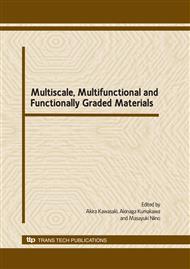p.353
p.361
p.367
p.373
p.379
p.387
p.393
p.401
p.407
Investigation of the Mechanical Properties in Al/Al3Zr FGMs Fabricated by Centrifugal Casting Method
Abstract:
Al-5mass%Zr FGMs fabricated by centrifugal casting method (CCM) have a very interesting microstructure. Since the intermetallics compounds of Al3Zr are plate in shape, Al3Zr platelet particles are almost oriented normal to the applied centrifugal-force direction. Considering this microstructure, the mechanical properties of Al/Al3Zr FGMs would vary for the same sample depending on the particles orientation and their volume fraction in the tested position. In this study, some mechanical properties of Al/Al3Zr FGMs were investigated. Al/Al3Zr FGMs rings were produced by CCM, under applied centrifugal force of 30, 60 and 120G (units of gravity). Microstructural observation along the centrifugal force direction was carried out. The platelet Al3Zr particles were almost oriented normal to the applied centrifugal force direction. The volume-fraction of Al3Zr particles increases close to the ring surface. Moreover, this distribution range of Al3Zr particles becomes broader with decreasing the applied centrifugal force. The same distribution trends were also observed for the hardness values. The Compression tests were also performed for further investigation of the mechanical properties. Samples under G=30 showed the lowest the 0.2%proof stress while those cast under G=120 had the highest 0.2% proof stress.
Info:
Periodical:
Pages:
379-384
Citation:
Online since:
October 2009
Authors:
Price:
Сopyright:
© 2010 Trans Tech Publications Ltd. All Rights Reserved
Share:
Citation:


